More gardens of religious communities
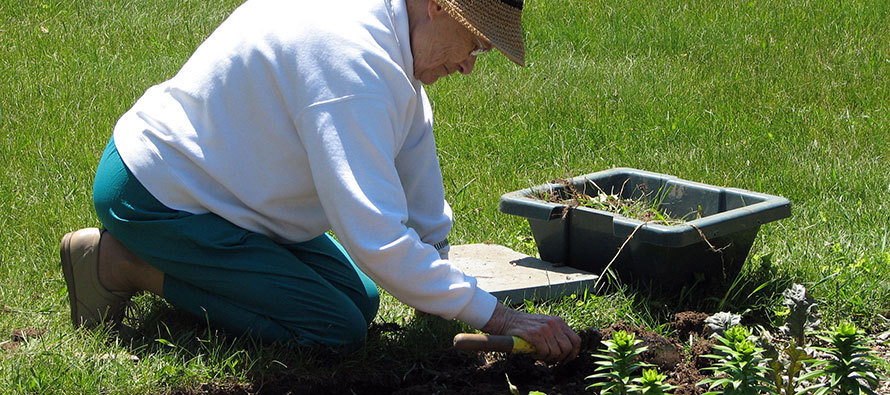
Image: Racine Dominican Sister Therese Van Thull, 88, says, “To be a gardener is to experience daily the awesome creative power of God.”
Racine Dominicans
Racine, Wisconsin
The Racine Dominicans are a community of vowed women religious sisters and lay associates in Racine, Wisconsin, a city on the shores of Lake Michigan south of Milwaukee. Sister Therese Van Thull, O.P., says, “Gardening has taught me a little about humility and patience. I can plant the seed and provide good soil, water, and protection, but I can’t force the growth. Deep within each seed is the potential to become a beautiful flower. It’s obviously not something I have done that creates this miracle.”
“Gardening gives me time to reflect on the beauty of nature that surrounds me,” she says. “There are the bird calls and songs, the small creatures that scamper as I move about, the butterflies flittering past, the deer watching my every move, the hummingbirds, the rabbits that love to munch on the tender seedlings, and so many others of God’s creatures. All of this bounty calls me to prayers of thanksgiving and gratitude to God for allowing me to nurture and tend to such beautiful plants and flowers that give joy to all who visit and view the garden.”
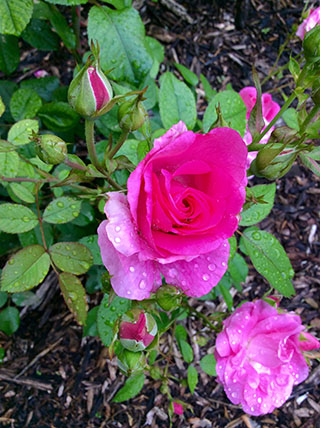
School Sisters of Notre Dame
Central Pacific Province
Mankato, Minnesota
The School Sisters of Notre Dame, Central Pacific Province has five campuses including in Mankato, Minnesota, where Sister Emma Buresh, S.S.N.D., tends crocuses, hostas, lilies, and magnificent roses.
“Flower gardening is a ministry where one can be outside enjoying the fresh air, hear the birds sing, and watch the miraculous growth and blossoming of flowers,” says Sister Buresh. “I enjoy the sisters' amazement at the beauty of the flowers and the joy they have picking the flowers to place in sisters' bedrooms.”
“The crocuses are plants that surprise me the most because they are the first to bloom, come through cold ground, and can stand the snow,” she says. “For me, the garden brings peace, quiet, and radical amazement, where I can marvel at God's gifts and the mysteries of the formation of the flowers. The garden is my heaven!”
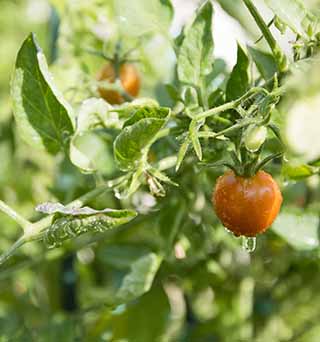
Daughters of Charity of St. Vincent de Paul
Province of St. Louise
St. Louis, Missouri
The Daughters of Charity are a community of religious women who serve the poorest and most abandoned individuals in today’s society. Their lives are ones of humility and simplicity shared in joyful community.
Sister Joan Warner, a Daughter of Charity in St. Louis, Missouri, says, “It is a joy to watch plants grow from seed through the cycle of growth and return to bearing seed. This is an aspect of vocation for me: following God and leading by my example to bring others to God.”
“Toiling in the soil grounds me,” she says, “helps me to be ever more part of nature. The garden is one of the places I most easily find God. The garden is where I am totally present to the moment with no other distractions. I am completely focused on the beauty of the plants and at peace in the mystery of the Divine.”
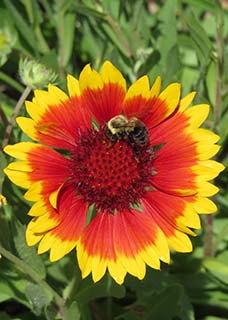
Congregation of Sisters of St. Agnes
Fond du Lac, Wisconsin
The Sisters of St. Agnes in Fond du Lac, Wisconsin, call themselves "women of spirit," dedicated to promoting justice and building community. Sister Jean Hinderer, C.S.A., the congregation’s spiritual director, leads retreats, enjoys photography, and writes a weekly blog (csavocations.blogspot.com) that has more than 25,000 followers. She finds in gardening yet another creative outlet for reflection and spiritual development.
“I like to think that God was the first organic gardener who did not use synthetic fertilizers or pesticides,” Sister Hinderer writes. “Organic gardeners think of the whole system—soil, water supply, people, wildlife, and even insects. Organic gardeners are concerned about building healthy soil and nurturing the connectedness of all things. And so it is with the Divine Gardener—offering us seeds of hope, integrity, risk, resiliency, dreams, purpose, passion, and call. It is up to all of us to provide these seeds with the best environment for germination so we will carry on the creativity and love of the Divine Gardener. And we need not be perfect at this—just willing.”
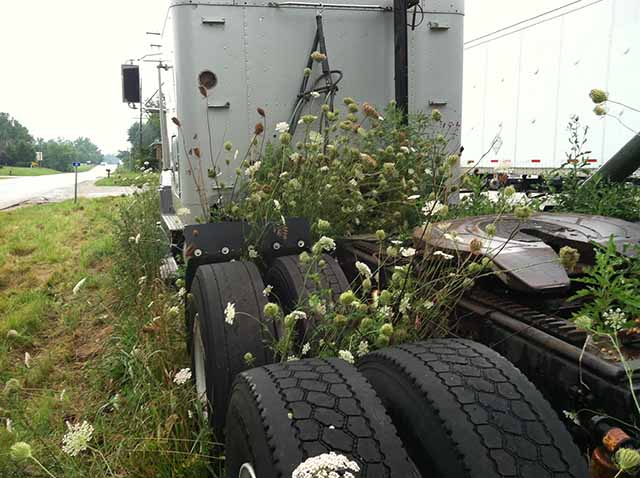
Conventual Franciscan Friars, Province of Our Lady of Consolation
Mount St. Francis, Indiana
“Some seed fell among thorns, and the thorns grew up and choked it" (Matthew 13:7). When Friar John Bamman, O.F.M Conv., of Mount St. Francis, Indiana, spotted a truck overgrown with weeds, he was reminded of this passage—and the importance of tending to spiritual growth.
“We Franciscan Friars are called to be on the move. It is uniquely tied to our charism,” he wrote in his blog (www.FriarTruck.wordpress.com). “Francis received the Gospel mandate to go forth to the world and be a missionary to plant the Gospel. Today there is not one continent on the globe that lacks a Franciscan presence to witness the Gospel. This is why the Gospel continues to move outward today and cannot remain parked on the shoulder, overrun by weeds. We are called to movement in the spiritual life. The weeds of sin always have the capacity to choke out spiritual growth and tie us down.”
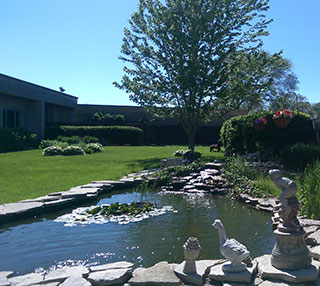
Midwest Augustinians
Chicago, Illinois
“Gardens have always been part of monasteries throughout the centuries. Perhaps it is because the Scriptures begin in a Garden (Eden) and end in a Garden (Paradise), or perhaps it is because of the cycle of nature mirroring the cycle of our lives—seed and sowing, nurturing and growing, full bloom and living, producing good fruit, fading and dying to a new beginning of life again!” writes Father Bernard C. Scianna, O.S.A., Prior Provincial of the Midwest Augustinians. “The other important part of the garden is the fountain or pond. The sound of flowing water is relaxing and calming. Having fish in the pond is also another sign of God's creation and life.”
“Time in the garden puts us in touch with the earth,” he continues, “and keeps us humble knowing that we are part of an amazing cycle of life. It is an oasis after a day in the office or classroom. It is the renewing power of the sun, and the perseverance through the storms. So get outside and get in touch with Creation and the Creator!”
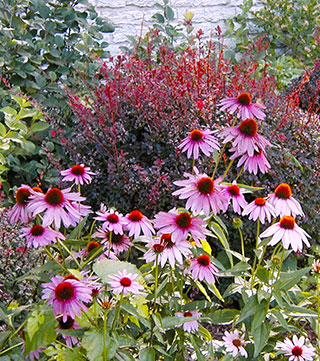
Poor Handmaids of Jesus Christ
Donaldson, Indiana
Sister Joetta Huelsmann has been a Poor Handmaids Sister for more than 46 years and is currently the director at John XXIII Retreat Center in Hartford City, Indiana. She writes, “Gardening had its beginnings in my youth growing up on a 200-acre farm in Illinois. My childhood memories of gardening were of hard labor and hot sweaty days, pulling weeds and hoeing to provide a place for healthy growth. I remember also the harvesting, the digging of the potatoes and the picking of big ripe juicy tomatoes. Now as an adult I have been planting gardens as a much-needed ritual each spring. It first began with flower gardens and during these last fifteen years I have added a vegetable garden.
“I appreciate the opportunity to dig my hands into the soil. It connects me to the Creator who created all things and gives us the ability to care for and nurture the plants. Being a gardener helps me to reflect more deeply on the spiritual life. As I plant the tiny radish and lettuce seeds in the spring I realize that it is God who first planted those seeds in me to follow in the footsteps of the disciples by becoming a Poor Handmaid of Jesus Christ Sister. As I water and weed the garden and thin out the plants, I realize that others have done the same for me. Fellow sisters, spiritual directors, friends, and pastors have nourished my life and helped me to sort out the growth from the distracting weeds.”
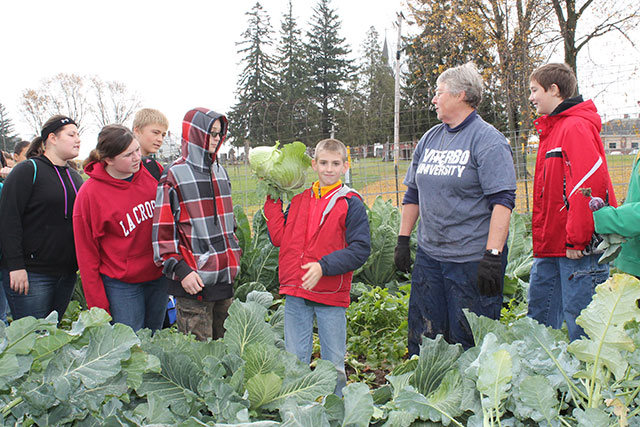
Franciscan Sisters of Perpetual Adoration
La Crosse, Wisconsin
The Franciscan Sisters of Perpetual Adoration in La Crosse, Wisconsin have a one-acre organic garden, managed by the community’s ecological advocate, Sister Lucy Slinger, F.S.P.A. Every year, with the help of volunteers, grade-school students, and interns from nearby Viterbo University, that acre yields around five tons of produce, including 35 different vegetables and fruits. The 10-year-old garden is part of a farm purchased by the sisters in 1895 to provide food for the congregation and the Franciscan hospital the sisters helped established to serve La Crosse. In 2012, the sisters designated this land to be used for sustainability education in perpetuity. Today, its bounty graces the sisters’ table and goes to local food banks.
“A primary goal of the garden is to reconnect people to nature in positive and spiritual dimensions of life,” says Sister Slinger. “The greatest companion in our garden is our gracious God, the Divine Mystery of life, visible in each and every moment for all who come to the garden. Blessed insights about life come as graced efforts to the planting, weeding, harvesting, and feasting as we take the time to see, hear, smell, taste, and feel the awesome connection with nature that can only come with a garden.”
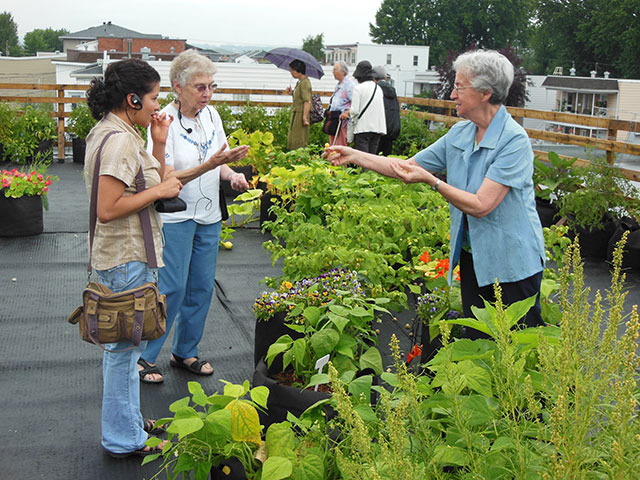
Congrégation de Notre-Dame
Québec City, Canada
The Congrégation de Notre-Dame is a community of women religious of apostolic faith, founded by Saint Marguerite Bourgeoys in Montreal in the 17th century. Sister Cécile Fiset, C.N.D. has been involved for many years with Québec City’s La Butineuse de Vanier, which educates about food safety and healthy eating through activities, workshops, projects, and games and provides affordable meals for low-income families. This community-supported agriculture project was created in 1993 to serve the neighborhood of Vanier.
With sponsorship from the Community Foundation of Greater Québec, La Butineuse was able to build a garden on the roof in 2012. The 175 pots on the roof contain more than 400 plants, sown with help from children. Transplanting workshops then help to continue the growth of the plants. In its first year, more than 650 pounds of fruits and vegetables were harvested.
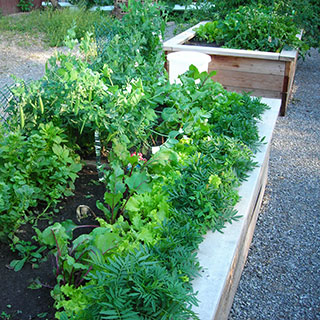
Faithful Companions of Jesus
Calgary, Canada
The property on which the Faithful Companions of Jesus have been living since 1883 is close to downtown Calgary, Canada, and yet it is a place to experience the beauty and peace of nature. The sisters refer to their whole outdoor area as the garden. A variety of flowering trees and bushes and tiny blue flowers along a riverbank delight the sisters and the many visitors to their Christian Life Centre in the spring. A grotto in honor of Our Lady can be seen through the pink blossoms of an ornamental fruit tree.
“What has gardening to do with my vocation? It provides a place of quiet and hope,” says Sister Theresa Smith, F.C.J. “Answering a religious vocation involves risk and hope. A garden provides beauty and peace that encourages a person to simply be. For me, gratitude grows, and I am renewed.”
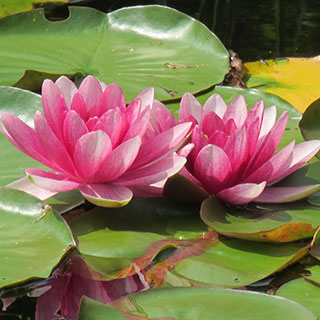
Sisters of St. Martha of Antigonish
Nova Scotia, Canada
Sister Donna Brady, C.S.M, in Antigonish, Nova Scotia, Canada, works in St. Theresa’s Garden at the community’s Bethany motherhouse. “Gardens are master artists and educators, creating beauty, harmony, and nourishment from diversity. They give a lot and ask of me, the gardener, full participation in return,” she says.
The attributes needed from her, she says, are time, energy, planning, openness to the unknown and unexpected, a sense of awe and wonder, awareness of limitations, and a willingness to learn and adapt. The benefits gardens share are exercise, connection with the four elements (earth, air, fire, and water), close encounters with life's transformative processes, sense stimulation, and physical and spiritual rewards for work well done.
“The lesson that everything belongs was brought home to me by both flowers and weeds. In my first years of gardening, flowers seemed frivolous and therefore to be excluded in a serious vegetable garden. Only later did I realize their beauty attracted pollinators and pest predators as well as drawing people passing by into contemplative moments,” she says.
“My ability to appreciate weeds was a longer, more strenuous journey. From my perspective it was all out warfare that consumed increasing amounts of time and energy. Slowly I began to admire their tenacity, their ability to grow in uninhabitable places and their ingenious and complex root and seed systems. Only then was I open to learn their important role in the garden: protecting the soil!” she says.
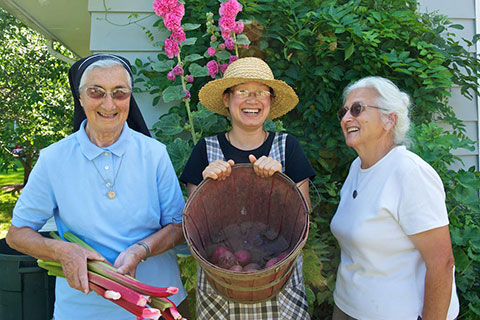
Sisters of the Sorrowful Mother
Marshfield, Wisconsin
The beautiful gardens of Sisters Rita Adlkofer and Barbara Hollweck, S.S.M. are filled with thousands of colorful blossoms and hundreds of thriving vegetables and are a popular attraction for their visitors and a great source of food for their community in Marshfield, Wisconsin. The sisters are proud to have dedicated their gardens to the foundress of the Sisters of the Sorrowful Mother Congregation, Venerable Mother Frances Streitel.
They tenderly care for the many different varieties of flowers and vegetables they grow, and every year have a bountiful harvest. They share the bulk of this harvest with local food pantries, hospital employees and volunteers, and other sisters, associates, and friends.
Gardening has been a very spiritual experience for them, as they honor Mother Frances with their bounty. Sister Mary Shin, who recently entered the community, spent a summer there as a postulant, enjoying the outdoors and tending the gardens with the sisters. In this way, gardening became a vocation activity. It helped them build a bond with their sister-to-be and show how gardening can help those in need, especially the poor, which is part of their charism.
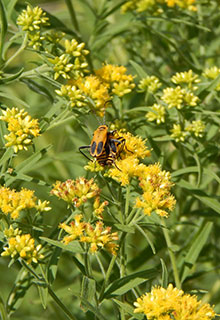
Sisters, Servants of the Immaculate Heart of Mary
Monroe, Michigan
When they renovated the motherhouse in Monroe, Michigan, one of the priorities of the Immaculate Heart of Mary sisters was green space—preserving and enhancing the gift of nature. The campus is home to native trees more than 100 years old, which provide historic and ecological value to the community and root it in place by keeping the sisters connected to the web of life.
The sisters converted 11 acres of lawn to meadow and prairie, improving the bio-diversity of the site and protecting existing natural habitat. (In 2010, the National Wildlife Federation declared the grounds an official Certified Wildlife Habitat site.) The reduction in costs associated with mowing lawn results in lower consumption of non-renewable energy. In the parking lots, vegetated swales handle the storm water runoff.
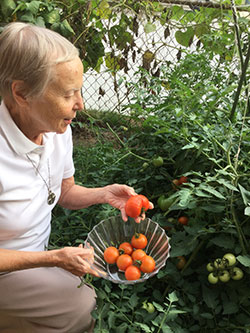
Franciscan Missionaries of Mary
Stickney, Illinois
Sisters Kim Anh Le and Beatrice Costagliola, F.M.M., of Stickney, Illinois, write: “Our Holy Father, Pope Francis quotes Saint Francis of Assisi’s beautiful canticle in his opening paragraph of Laudato Sí: ‘Praise to you, my Lord, through our Sister, Mother Earth, who sustains and governs us, and who produces various fruit with colored flowers and herbs.’ We sisters, as followers of Saint Francis, have a special love for all growing things. Although our space is limited, the small patch of earth that we cultivate has rewarded us abundantly with vegetables and herbs. On a regular basis we happily deliver to our kitchen an armful of fresh lettuce, string beans, cucumbers, and tomatoes, which we, equally happily, devour. We love gardening because by cultivating the earth we are united with all those millions of people who work under the hot sun to earn their living and to sustain their families. We are part of a great network of peasants who appreciate the soil and value the seeds of life.”
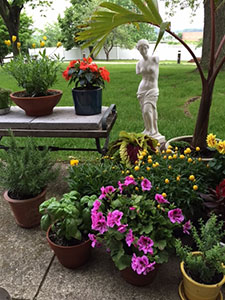
Salvatorians
U.S.A Province
“We see God in nature, in his flowers,” writes Brother Peter Farnesi, S.D.S., of Milwaukee, Wisconsin, the headquarters of the Salvatorians in the United States.
“Flowers, to me, mean everything. When I see flowers, I see the beauty of creation that God made, which inspires me to pray. Walking in a beautiful garden to me is like walking with God in heaven. His presence is everywhere in nature.”
“The early missionaries always had gardens for meditating and praying, and that helped inspire me to become a brother and missionary,” he says.
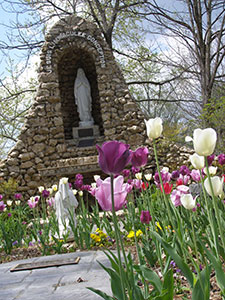
Sisters of Charity of Nazareth
Nazareth, Kentucky
Mary’s Garden on the campus of the Sisters of Charity of Nazareth in Nazareth, Kentucky, is a favorite visiting place for many. Flowers bloom from the center in front of the statue of the Immaculate Conception. Purple petunias, red roses, and white lilies circle the four sides of the garden, each marked by a plaque of the mysteries of the rosary, and there are benches upon which to say the rosary.
“The garden is a place where prayers are said by many sisters and friends of the congregation,” says Sister Rita Spalding, S.C.N.
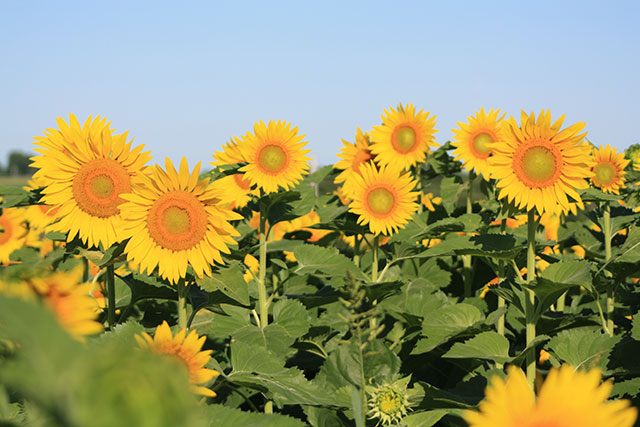
Sinsinawa Dominican Sisters
Sinsinawa, Wisconsin
Sinsinawa Dominican Sisters are dedicated to preaching and teaching the Gospel. They believe that at the heart of ministry is relationship.
Today, more than 400 Sinsinawa Dominican Sisters in the United States and abroad participate in the mission shared by all Dominicans: to proclaim the Gospel in word and deed. Currently, their missions outside the U.S. include Bolivia and Trinidad and Tobago.
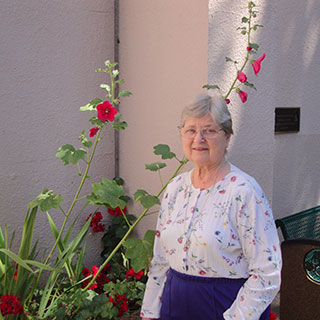
Sisters of Mercy of California
San Francisco, California
“I had been caring for a garden where I live for many years, as a hobby and as a work of beauty to inspire sisters and visitors attending retreats at Mercy Center,” says Sister Helen Gilsdorf, R.S.M. “Sometimes people help pull weeds or just stop to talk with me.”
Mercy Center Burlingame is an internationally known conference and retreat center sponsored by the Sisters of Mercy, located on a 40-acre site 15 miles south of San Francisco. The sisters provide a peaceful environment for women and men of diverse faiths and backgrounds to nourish their spiritual and professional lives.
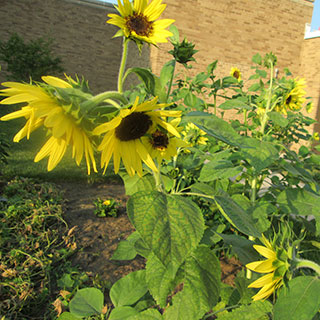
Sisters of Mercy of Illinois
Chicago, Illinois
For Sister Norena Gawronski, R.S.M., a retired Sister of Mercy residing at Mercy Circle in Chicago, gardens are important reminders of vocation. She says, “Gardening needs the giving and the receiving of watering, weeding, hoeing. The good Lord through nature provides sunlight, rain, oxygen, and nourishment.” Her favorite season is the middle of summer, when it is time to enjoy the harvest of vegetables and fruits.
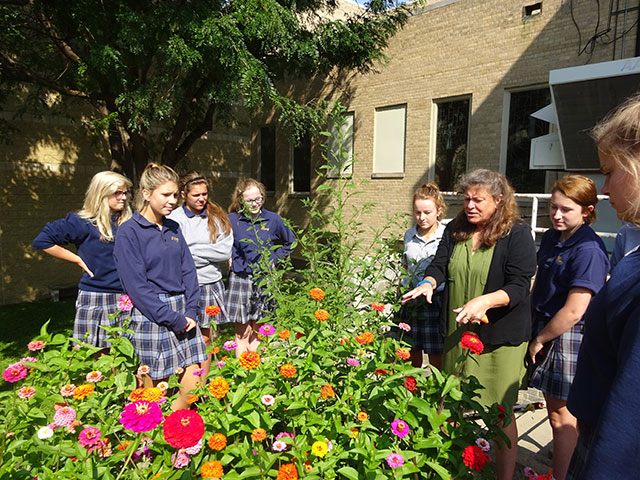
Sisters of Mercy West Midwest Community
Omaha, Nebraska
The mascot of Mercy High School in Omaha, Nebraska, is the Monarch. The school is aware of the diminishment of feeding areas for monarch butterflies, and one of its science classes planted an area to feed migrating monarchs.
“It is not a classic garden, but it is an environmentally friendly garden,” says Sister Delores Hannon, R.S.M., president of Mercy High School.
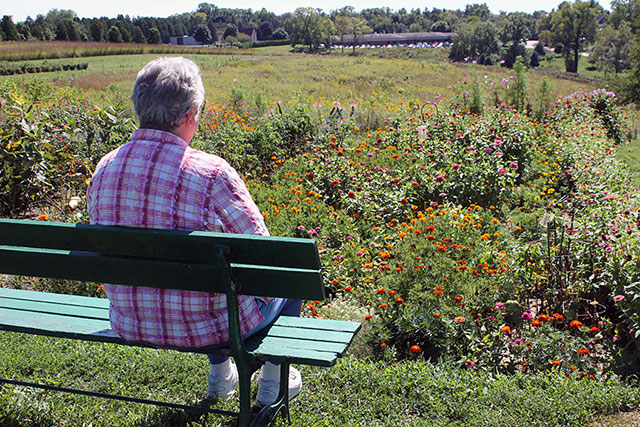
Sisters of St. Francis of Iowa
Dubuque, Iowa
“The world is charged with the grandeur of God,” said Gerard Manley Hopkins. A taste of that grandeur has prevailed in many beautiful gardens on the premises of Mount St. Francis in Dubuque, Iowa.
Sister Julitta Deppe, O.S.F. planted one of those gardens behind the convent. Nourished by God-given rain, hot weather, fertile soil, and plentiful sunshine, the garden has flourished beyond expectation.
“Having grown up on a farm in Iowa, nearness to the soil, raising vegetables and flowers, and literally living off the soil was my daily experience,” she says. “My love and gratitude to my Creator, already at a young age, has continued to grow, develop, and be nourished by experiencing the magnificence of heaven on earth.”
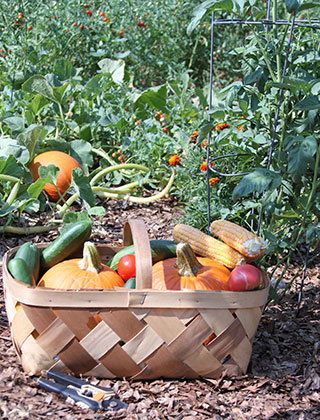
Sisters of Mercy of North Carolina Foundation
Charlotte, North Carolina
Sister Paula Diann Marlin, R.S.M. writes, “Hoeing, raking, weeding, and pruning are physical tasks, which are good for the body. The activity frees the mind from stress and anxiety. The peaceful setting and natural beauty of the earth enhance the spirit. It prompts my heart to overflow with gratitude for God’s gifts of creation.”
In early spring, Sister Marlin hoes, adds composted soil and fertilizer, and removes weeds and rocks, preparing the soil. In late spring, she lays out the garden so that each vegetable has what it needs to grow and thrive. Tomatoes and peppers need stakes. Green beans, snow peas and cucumbers like to climb and cling to fences. Vine crops need space to spread out and require pruning so they don’t overwhelm other plants. Interspaced herbs and marigolds add color, welcome bees, and deter pests. Summer requires intensive pruning, weeding, picking, and watering for a continuous harvest. When the growth cycle ends, raked leaves provide a beneficial, protective covering in winter.
“Are we not like plants?” she writes. “We thrive in a carefully prepared environment. We are individuals who blossom into what we are meant to be with help, encouragement, and pruning. We go through seasons of growth, change, letting go, and discouragement. We each have a purpose in life and distinct gifts and inner beauty that grow through life’s cycles.”
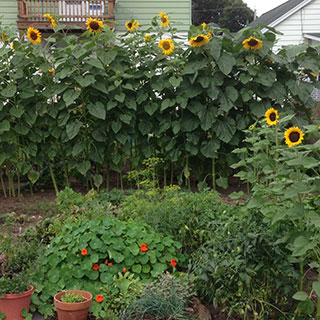
Sisters of St. Francis of the Neumann Communities
Pittsburgh, Pennsylvania
“What inspires me to want to garden? It nourishes my body and spirit. What God does with Mother Earth, imagination, care, and some fertile ground provides all the inspiration necessary for me,” says Sister Anne McNulty, O.S.F. in Pittsburgh, Pennsylvania. “Gardening provides me a place of action, for vigorous theological reflection, as well as a magnificent place for releasing energy."
Sister McNulty’s favorite flowers are sunflowers. “The passage of time between seed and full growth is just absolutely remarkable,” she says. Her most enjoyable gardening moment was digging up her first potato. “This garden is our community garden. I delight knowing others enjoy what it produces.” she says. “I find great satisfaction in remembering the first seeds showing green leaflets—spiritual treasures!—be it veggies or flowers. Even weeds have the power to inspire.”
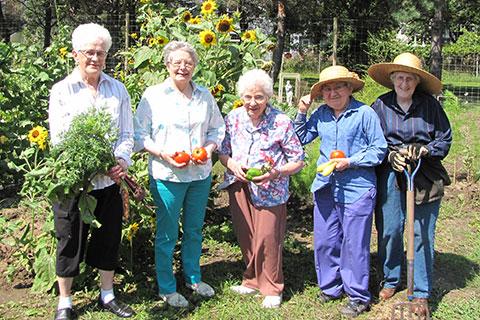
Sisters of St. Francis of Minnesota
Rochester, Minnesota
According to Sister Rafael Tilton, O.S.F., many of the Franciscans in Rochester are originally from Minnesota, a verdant agricultural area, so it’s no wonder that many of them grew up gardening. And it’s no surprise that fresh vegetables from the gardens at Assisi Heights have become an integral part of their religious life.
Sister Martha Mathew, O.S.F. is one of the several regulars who tend to the half-acre or so that’s called Umbrian Gardens. She says, “Recently, I’ve begun gardening in earnest. I’ve learned there is more to be gained than the harvest. Although that is the main goal, a fruitful harvest depends on nutritious soil, good seeds, proper planting, and daily care.”
Sister Alice Thraen, O.S.F. has learned what soil types, moisture, and temperature have to do with the growing process. “I’m intrigued,” she says, “with how a tiny black speck can produce a beautiful flower, a fruit, or a grain; not to mention the patience and perseverance that are part of waiting for plants to grow, bloom, and produce.”
And for Sister LaDonna Maier, O.S.F., a connection between gardening and God’s overall plan is that “God created the good ground of our bodies, souls, and the earth. Gardening is ‘choosing the better part.’ It helps me to occupy my mind with prayer and positive thoughts, as well to plan which flowers will adorn the altar and feed Sister Alice’s bees.”
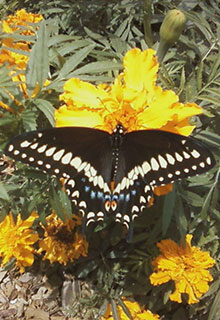
Sisters of St. Joseph of New York
Brentwood, New York
The Sisters of St. Joseph maintain the Brentwood Organic Garden in Brentwood, New York, and Sister Heather Ganz, C.S.J. writes a blog, “Thoughts from the Garden” (csjgarden.blogspot.com/), about it. Their garden is intended to promote ecological conservation.
“Things want to live. It seems to be true, and my role is simply (or not so simply) to support that life,” Sister Ganz writes. “I feel the crunch of so much to do in order to support the life around me. [But] I don’t have to do everything, be everywhere, control anything, or save the world, I only have to love it, all of it. Everything is oriented towards life, and I need to support that life. The success of my days, however, is not measured by how many seedlings I get planted into the ground, but by how much I loved each one of those little lives and all of the lives, great and small, that have crossed my path that day.”
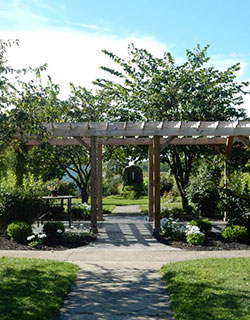
Sisters of St. Francis of Ohio
Tiffin, Ohio
“Gardening is similar to discerning vocation: listening and following the invitation, seeking counsel, making plans, visiting communities. God nurtures one on the journey,” says Sister Marie Reinhart, O.S.F., in Tiffin, Ohio.
“My garden can draw a person into the inner garden of one’s own soul and listen to God speaking in the inner stillness and beauty, perhaps calling the individual to come apart, letting God be the center of one’s life, drawing others to this source.”
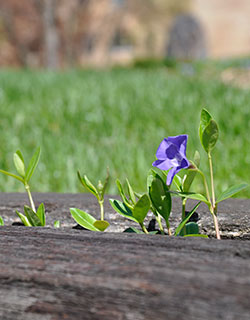
Congregation of the Sisters of the Holy Cross
Park City, Utah
Who would have guessed there are cultural differences in gardening? Sister Mary Ann Pajakowski, C.S.C., in Park City, Utah, learned an interesting lesson from a sister from Bangladesh who offered to help her plant seeds. “Instead of planting in rows, she scattered them so they came up in patches. This is how we do it at home, she said. Why not? Seeing the garden as part of the rest of our space in the yard, and not something separate, helps us to appreciate all that germinates and survives,” Sister Pajakowski says.
Failure is another important lesson of gardening. “The poor results of one’s gardening efforts are a humbling experience—be it failed germination, a July frost, or hungry visitors in the night. Relating to the vagaries of backyard friends (moose, rabbits, raccoons, deer, ermine, voles, chipmunks, or pot guts) goes to the heart of a lived lesson—you may or may not get your needs or your heart’s desire met this season,” she says.
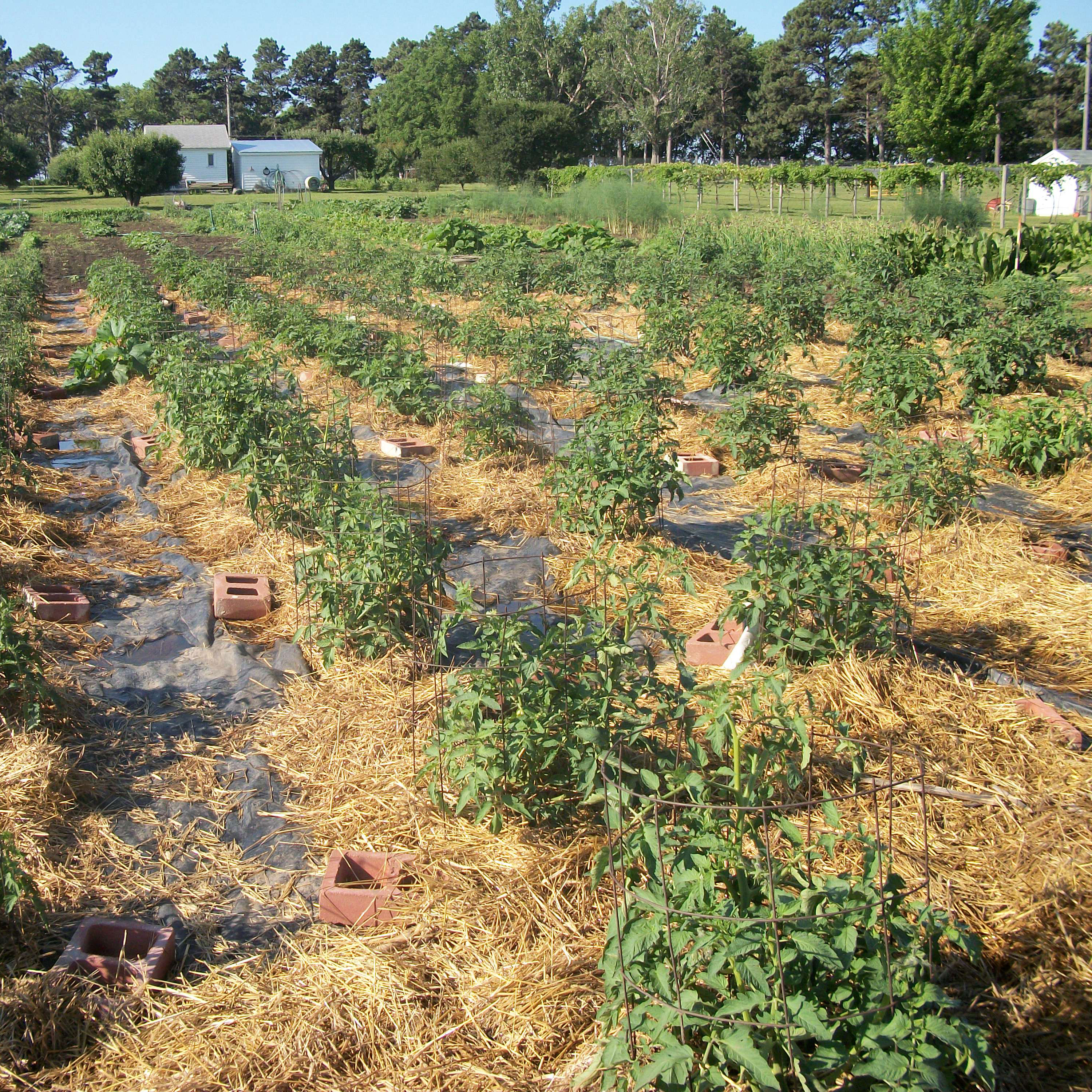
Yankton Benedictines of Sacred Heart Monastery
Yankton, South Dakota
Sister Carol Jean VanDenHemel, O.S.B., in Yankton, South Dakota, writes, “As Benedictines we profess a vow of stability; we commit ourselves to living among members of one community in one place. This promise ties us closely to the tradition of our monastic ancestors to care for and stewardship of the place where we live in community. This stability also calls us to work both together and for each other; while Benedict never specifies 'gardening', his Rule repeatedly reminds the monastics that they are to ‘live by the labor of their hands.’”
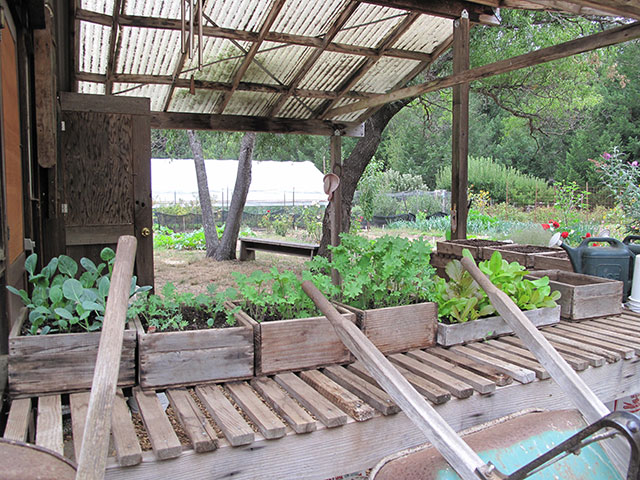
Trappistine Cistercian nuns of Redwoods Monastery
Whitethorn, California
Sister Ann Marie Buss, O.C.S.O., of the Redwoods Monastery in Whitethorn, California, has two gardening favorites.
“Spring is my favorite season,” she says. “The compost is turned; then hauled by wheelbarrows to open beds. There it nurtures the small seedlings as they begin their life. Spring generates wholeness, new life, and vitality to what had died in fall and winter and became the compost. Nothing is wasted but instead is recycled for something new.”
“My favorite vegetable is the pole bean,” she says. “I get excited when the flowers first show themselves. Though their roots run deep into the ground, pole beans are very susceptible to frost. They are fragile and yet their shoots can grow up to 12 feet high! I cherish pole beans for they exemplify my yearning for wisdom and understanding, while also remind me of my need for patience and endurance to grapple with the frosts that may come my way.”
Tags
Related
- Literature makes good people better
- Icons: An age-old entrée into the divine
- Religious communities have deep and diverse roots
- Scientific wonder is God’s handiwork
- Respite and renewal brought to you by religious communities
- Lives that lead to God: Biographies and memoirs
- Religious orders aid and advocate for migrants
- Rural religious take to the highways and byways
- Divine design: The holiness of place
- More prayer spaces of religious communities Read More
Most Viewed
- Find your spirituality type quiz
- Questions and answers about religious vocations
- Celibacy quiz: Could I be a nun? Could I be a brother? Could I be a priest?
- Resources for older discerners or those with physical and developmental differences
- About Vocation Network and VISION Guide

